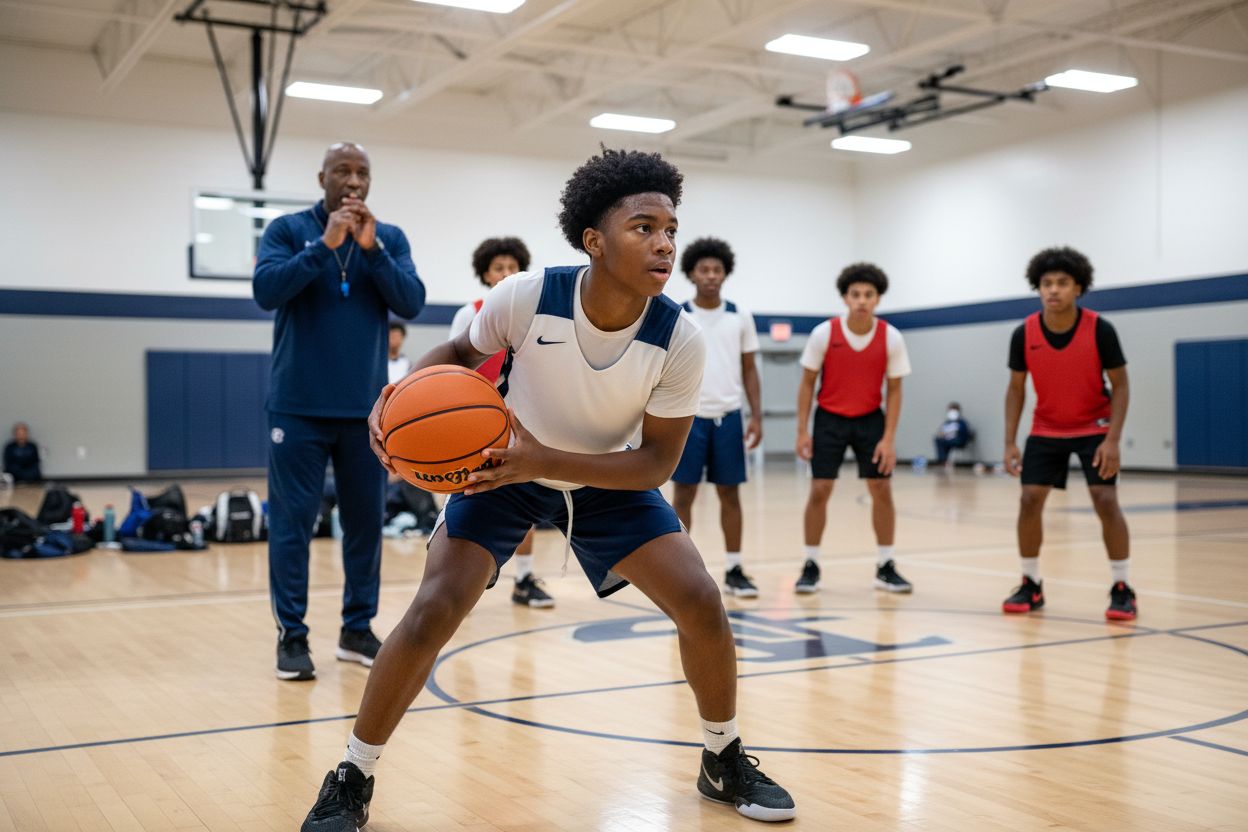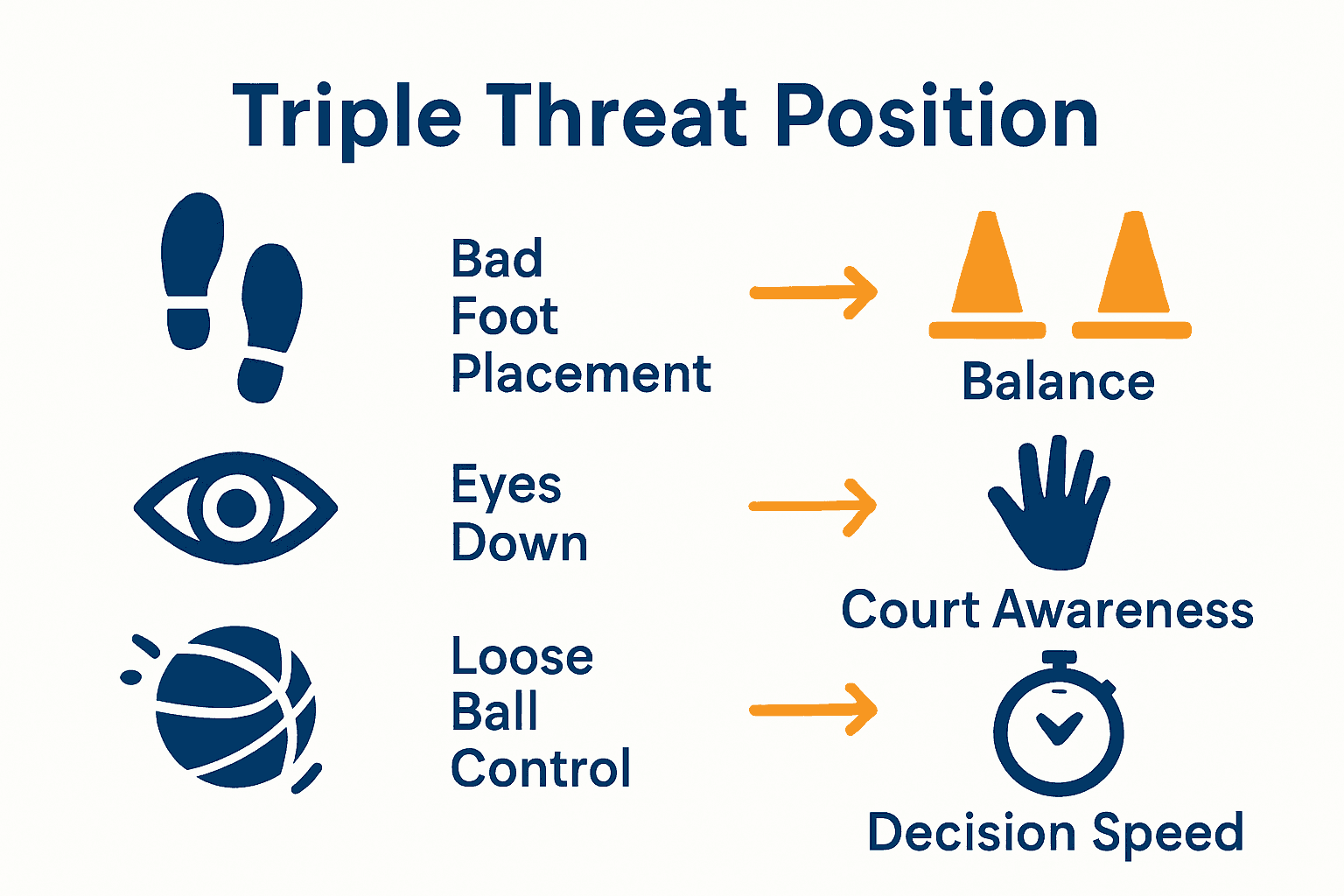Nearly every offensive play in basketball starts with the same secret weapon. Over 80 percent of successful attacks begin from the triple threat position, giving players a clear advantage by keeping their options wide open. For athletes and coaches alike, understanding this simple stance is essential for outsmarting defenders and creating space on the court. Mastering the body mechanics and strategic thinking behind triple threat play can shape a player’s effectiveness and transform game outcomes.
Table of Contents
- Defining The Triple Threat Position In Basketball
- Key Body Mechanics And Execution Techniques
- Situational Applications During Gameplay
- Coaching Responsibilities And Communication Strategies
- Common Mistakes And Effective Practice Drills
Key Takeaways
| Point | Details |
|---|---|
| Fundamental Technique | The triple threat position enhances offensive versatility by allowing quick transitions between shooting, passing, and dribbling. |
| Coaching Strategies | Effective teaching requires breaking down movements and using memorable phrases to reinforce player learning and instinctive execution. |
| Common Errors | Players often struggle with court awareness; drills should focus on keeping eyes up and improving decision-making speed while in the stance. |
| Dynamic Application | The triple threat is a situational tool that should be used strategically to create offensive opportunities without hindering momentum. |
Defining the Triple Threat Position in Basketball
The triple threat position represents a fundamental basketball stance that provides maximum offensive versatility, giving players multiple strategic options within seconds of receiving a pass. According to research from mojo.sport, this position enables players to quickly transition between shooting, passing, or dribbling without telegraphing their next move.
To execute the triple threat position, players must adopt a specific athletic stance that maximizes mobility and decision-making speed. Key elements include:
- Feet slightly wider than shoulder-width apart
- Knees flexed and bent, maintaining balance
- Weight distributed on the balls of the feet
- Ball held in a protective pocket near the hip
- Eyes up, scanning the court for potential opportunities
As Wikipedia notes, the primary advantage of the triple threat position is its ability to keep defenders guessing. By maintaining a neutral stance, players can employ techniques like jab steps and pump fakes to create separation and generate scoring opportunities. Coaches often teach this position as a core offensive fundamental that empowers players to make quick, strategic decisions without losing their competitive advantage.
Key Body Mechanics and Execution Techniques
The key to mastering the triple threat position lies in understanding the precise body mechanics that create maximum offensive potential. According to research from Hoops Beast, executing this stance requires meticulous attention to fundamental techniques that give players a strategic advantage.
Body positioning in the triple threat involves several critical elements:
- Foot Placement: Position feet shoulder-width apart, with shooting foot slightly ahead
- Weight Distribution: Center weight on the balls of the feet for quick movement
- Spine Alignment: Maintain a straight back with chin positioned over the shooting foot
- Ball Control: Hold the ball in a protective pocket near the hip
According to research from Scribd, hand and arm positioning is equally crucial. Players should spread their fingertips, keep the non-shooting hand on the side of the ball, and maintain elbows at approximately 90-degree angles. The goal is to create a neutral stance that allows instant transitions between shooting, passing, and dribbling.

Here’s a summary of key triple threat body mechanics and execution techniques:
| Element | Proper Technique | Purpose |
|---|---|---|
| Foot Placement | Shoulder-width Shooting foot ahead |
Stability Quick pivoting |
| Weight Distribution | Balls of feet | Faster movement |
| Spine Alignment | Back straight Chin over shooting foot |
Balance Proper form |
| Ball Control | Protective pocket near hip | Security Readiness |
| Hand Position | Fingertips spread Elbow ~90° |
Control Versatility |
| Vision | Eyes up, scanning court | Awareness Decision speed |
Mastering deception techniques like jab steps, head fakes, and pump fakes becomes essential in the triple threat position. These subtle movements can create separation from defenders and open up scoring opportunities, transforming this fundamental stance from a simple receiving position into a dynamic offensive weapon.
Situational Applications During Gameplay
Triple threat position is not just a static stance but a dynamic tool for creating offensive opportunities across different game scenarios. According to Hoops Beast, its primary strategic value lies in keeping defenders constantly uncertain about the offensive player’s next move.
In practice, coaches can leverage triple threat positioning through targeted training techniques:
- Perimeter catch and face situations
- Wing entry passes
- Quick decision-making drills
- Pressure scenario simulations
- Transition offense opportunities
Mojo Sport recommends specific drill approaches to reinforce situational awareness, such as number-calling exercises that encourage players to maintain court vision while in the triple threat stance. These drills help players develop muscle memory and decision-making speed without telegraphing their intentions.
While powerful, coaches must also recognize the triple threat position’s potential limitations.
Extended time in this stance can slow offensive momentum and potentially violate shot-clock efficiency, especially when compared to more fluid offensive styles. The key is teaching players to use the triple threat as a strategic tool—a momentary advantage for creating separation—rather than a prolonged holding pattern.
Coaching Responsibilities and Communication Strategies
Teaching the triple threat position requires more than technical instruction—it demands a strategic approach to player development and communication. Mojo Sport highlights coach Evan Unrau’s critical insight that effective coaching involves packaging fundamental skills into digestible, memorable concepts.
Key communication strategies for coaches include:
- Use simple, actionable phrases
- Create engaging, fun learning environments
- Break down complex movements into smaller steps
- Provide immediate, constructive feedback
- Demonstrate techniques visually and kinetically
Coaches should focus on memory-friendly coaching cues that reinforce core principles. Phrases like “be on balance,” “eyes up,” and “protecting the basketball” help players internalize the triple threat position’s essential elements. The goal is to transform technical instruction into intuitive muscle memory through repetitive, enjoyable drill sequences that don’t overwhelm players.
Ultimately, successful triple threat coaching transcends mechanical teaching. By developing leadership skills in players, coaches can help athletes understand not just how to execute the stance, but when and why to use it—turning a fundamental technique into a strategic weapon on the basketball court.
Common Mistakes and Effective Practice Drills
Mastering the triple threat position requires identifying and correcting common player errors through targeted, strategic practice techniques. Scribd’s lesson plans outline several specialized drills designed to address fundamental mistakes players typically encounter.
Key drills to address common mistakes include:
- Random Stops Drill: Testing and improving player balance
- Military Drill: Developing quick jab-step reactions
- Self-Toss Drill: Enhancing decision-making speed
- Help Drill: Introducing defensive pressure scenarios
Mojo Sport highlights one of the most critical errors players make: looking down instead of maintaining court awareness. To combat this, coaches can implement a simple yet effective exercise where the coach holds up numbers under the rim while players must catch the ball, square up, and immediately call out the number—forcing players to keep their eyes up and develop spatial awareness.
By integrating these fundamental basketball drills into regular practice, coaches can systematically break down and rebuild players’ triple threat technique, transforming common mistakes into opportunities for skill development and muscle memory refinement.

Master the Triple Threat Position with Tools Designed for Coaches
The triple threat position demands precision, quick decision-making, and confident execution. If you struggle with teaching players how to stay balanced, keep their eyes up, and react swiftly under pressure, you are not alone. Coaches often find it challenging to break down the stance into simple, repeatable steps that build lasting muscle memory. This is where having the right resources makes all the difference.
Take control of your coaching by exploring our comprehensive collection of Basketball Drills - Hoop Mentality specially designed to sharpen core skills like jab steps, pump fakes, and protecting the ball.

Equip your players with structured practice plans and proven techniques so they can confidently use the triple threat to create opportunities on the court. Visit Hoop Mentality now and find everything you need to transform fundamental skills into winning strategies. Start coaching smarter today with our expert Basketball Playbooks - Hoop Mentality and elevate your team’s performance immediately.
Frequently Asked Questions
What is the triple threat position in basketball?
The triple threat position is a fundamental stance that allows players to quickly transition between shooting, passing, or dribbling, maximizing offensive versatility immediately after receiving a pass.
How do I properly execute the triple threat position?
To execute the triple threat position, stand with feet shoulder-width apart, knees flexed, weight on the balls of your feet, and hold the ball in a protective pocket near your hip while keeping your eyes up to scan the court.
What are some common mistakes to avoid when using the triple threat position?
Common mistakes include looking down instead of maintaining court awareness, poor foot placement, and improper ball control. Practicing exercises that encourage balance and awareness can help correct these errors.
How can coaches teach the triple threat position effectively?
Coaches can teach the triple threat position by using simple, actionable phrases, breaking down the technique into smaller steps, providing immediate feedback, and incorporating fun, engaging drills to reinforce practice and muscle memory.

